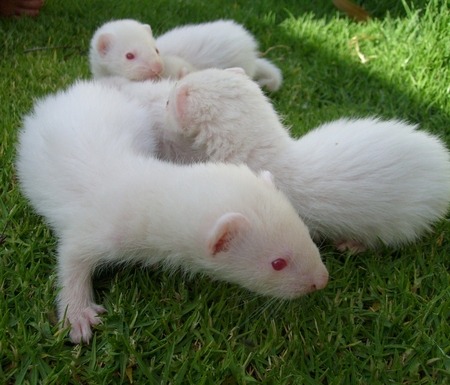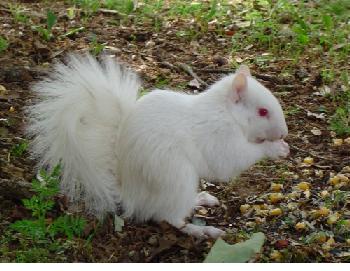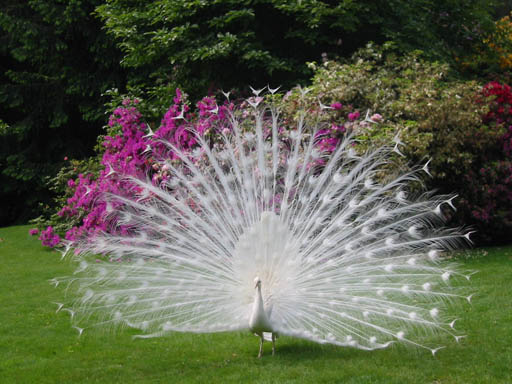|
|
|---|
Thursday, January 13, 2011
If you are like me, you may not have ever heard of a saola, but a few of them really do exist, like maybe 250 or so in the wild, and none at all in captivity. Scientists didn't even know about these animals until 1992, and that's when a group from the World Wildlife Fund and the Vietnamese Ministry of Forestry "discovered" them. Of course, the native people in Laos and Vietnam already knew about the saola, and in fact they used to hunt them sometimes. So the way the scientists found out about saolas was that they saw some skulls with horns that were in hunters' houses.
After that, the scientists "described" the saola, and they named it Pseudoryx nghetinhensis. They planned to spend three months studying the saola, after which they thought they would know everything there was to know about it, but 15 years later, the scientists still have not seen a single one of these animals in the wild.
Another name for the saola is Vu Quang ox, and sometimes they have been called Asian unicorns. The name saola, which is pronounced sow-la, is from the Tai language of Vietnam and also is the same in the Lao language. And what it means is "spinning wheel posts." The people gave the animal that name because it had two long, straight horns that looked like the posts that hold up their spinning wheels. The Hmong people of Lao call the animal saht-supahp, which means "the polite animal," because it moves so quietly through the forest.
Saola live in the Annamite Range of mountains that is partly in Vietnam and partly in Laos. In the wet season, they stay in the mountain forests, and then during the winter, they move down to the lowlands. They are very, very shy, and they never go into farmers' fields or anywhere close to a village. Saola are part of the bovine family, so some of their closest relatives are cattle and buffaloes. But since they are not actually cattle, they are classified as antelopes. Plus they are also sort of like goats, so it's all very confusing.
What saola mostly like to eat is small leafy plants, like especially fig leaves. They mark their territory by opening up a flap on their snouts where there are scent glands. Then they rub these glands on stuff, which leaves a musky sort of strong-smelling paste. And after they've done that, everybody knows they have been there! Scientists think that the scent glands of the saola are the biggest of any kind of mammal alive today.
Anyway, like I told you in the beginning, there are very few saola left, and this means that they are CRITICALLY ENDANGERED. So they might go extinct, which would be sad, since we only just now figured out that they exist. This past August, some villagers in Laos captured a saola, but it died before it could be released back into the wild. Sadly, every saola that has been caught has died pretty quickly afterwards, so it seems like this animal can't be kept in zoos or anyplace like that.
The main reason that there are so few saola left is because of hunting. And it wasn't really because people were hunting especially for saola. What happened was that when people started hunting using wire snare-traps, the saola would get caught in them, even though the snares were meant for other animals. And the reason that people do so much hunting is because the richer people in the cities like to eat wild meat, and they will pay pretty good for it.
Anyway, people are trying to find ways to keep the saola from going extinct, like by making more reserves for them and stuff like that. I don't know if they will save this animal or not, but I think it would be really, really nice if they could.
After that, the scientists "described" the saola, and they named it Pseudoryx nghetinhensis. They planned to spend three months studying the saola, after which they thought they would know everything there was to know about it, but 15 years later, the scientists still have not seen a single one of these animals in the wild.
Another name for the saola is Vu Quang ox, and sometimes they have been called Asian unicorns. The name saola, which is pronounced sow-la, is from the Tai language of Vietnam and also is the same in the Lao language. And what it means is "spinning wheel posts." The people gave the animal that name because it had two long, straight horns that looked like the posts that hold up their spinning wheels. The Hmong people of Lao call the animal saht-supahp, which means "the polite animal," because it moves so quietly through the forest.
Saola live in the Annamite Range of mountains that is partly in Vietnam and partly in Laos. In the wet season, they stay in the mountain forests, and then during the winter, they move down to the lowlands. They are very, very shy, and they never go into farmers' fields or anywhere close to a village. Saola are part of the bovine family, so some of their closest relatives are cattle and buffaloes. But since they are not actually cattle, they are classified as antelopes. Plus they are also sort of like goats, so it's all very confusing.
What saola mostly like to eat is small leafy plants, like especially fig leaves. They mark their territory by opening up a flap on their snouts where there are scent glands. Then they rub these glands on stuff, which leaves a musky sort of strong-smelling paste. And after they've done that, everybody knows they have been there! Scientists think that the scent glands of the saola are the biggest of any kind of mammal alive today.
Anyway, like I told you in the beginning, there are very few saola left, and this means that they are CRITICALLY ENDANGERED. So they might go extinct, which would be sad, since we only just now figured out that they exist. This past August, some villagers in Laos captured a saola, but it died before it could be released back into the wild. Sadly, every saola that has been caught has died pretty quickly afterwards, so it seems like this animal can't be kept in zoos or anyplace like that.
The main reason that there are so few saola left is because of hunting. And it wasn't really because people were hunting especially for saola. What happened was that when people started hunting using wire snare-traps, the saola would get caught in them, even though the snares were meant for other animals. And the reason that people do so much hunting is because the richer people in the cities like to eat wild meat, and they will pay pretty good for it.
Anyway, people are trying to find ways to keep the saola from going extinct, like by making more reserves for them and stuff like that. I don't know if they will save this animal or not, but I think it would be really, really nice if they could.
0 Comments:
Subscribe to:
Post Comments (Atom)





















